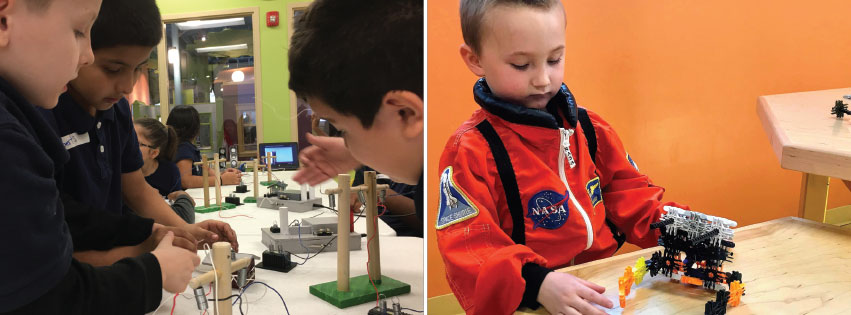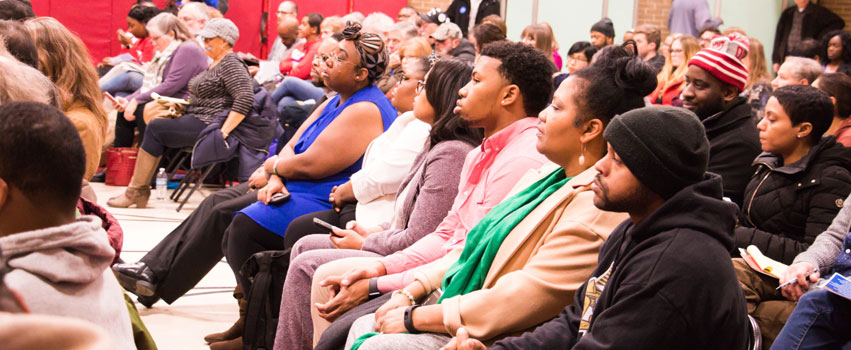STEAM Education at the Playhouse

Over the past few years, the Peoria PlayHouse Children’s Museum has been a proud participant in the STEAM (Science, Technology, Engineering, Art and Math) education collaborative spearheaded by the University of Illinois Extension. The mission of the PlayHouse is to help children become explorers and creators of the world. Scientists, engineers and artists—using the tools of math, technology and materials—are exemplary explorers and creators of the world. Through exhibits and programs, the PlayHouse offers children and families various ways to learn about these creative and technical areas. Within Peoria’s network of STEAM education offerings, the PlayHouse introduces very young children to these disciplines, sparking their curiosity and hopefully leading them to explore and learn from STEAM resources throughout the region.
Playhouse Exhibits
Museum exhibits are excellent tools to engage the imagination, cultivate curiosity, and teach children about cause and effect. Children are natural scientists, and STEAM-related learning can be seen walking through the exhibits and watching them at play. In “Motion Commotion,” they feed balls into wind tubes to see what will happen, and often invent obstacles for themselves, finding new ways to get these colorful balls into the central hopper. At the water table, children notice the current and figure out how to stop the water with a dam—or move the water by building pipes. On the Sand Porch, they dig tunnels beneath kinetic sand and watch it collapse.
Museums also have the opportunity to explicitly teach science and engineering concepts. At the PlayHouse this is best seen in the SciLab exhibit area, where children can compare heart rates or see the myriad products made out of corn. Families can play at three tables offering different types of building blocks and toys. At the “It’s Electric” station, visitors learn about electrical circuits and find ways to turn on lights, sound buzzers and activate motors.
Our staff often hear stories about children leaving the museum and asking for new toys to explore water in the bathtub, or parents purchasing kinetic sand or Magna-Tiles to allow them to continue building at home. These stories demonstrate what our exhibits do so well: stimulate children’s curiosity, encourage them to explore, support their urge to experiment. In this way, visits to the PlayHouse foster key traits of a scientist.
Playhouse Programs
Facilitated programs are critical for teaching deeper STEAM learning. The PlayHouse offers programs for families, school groups and home schoolers that teach STEAM skills while encouraging innovation.
Monthly maker workshops engage children and families in using new tools and materials to create. Each program is different: one month’s workshop might find participants creating light-up fashion accessories; another has them building sculptures; and in yet another they make (and eat!) candy. In accordance with the PlayHouse’s focus on innovation, participants do not follow a pre-set model. Instead, they are first introduced to new tools and skills, and then design and make their own innovative objects. PlayHouse educators make sure children are given space to explore materials, as well as their newfound skills, with the result being something that’s uniquely theirs.
The PlayHouse offers two STEAM-related field trip experiences. In collaboration with the Illinois Science & Energy Innovation Foundation (ISEIF) and the Illinois State University Center for Mathematics, Science, and Technology (CeMaST), we offer “Spotlight: Electricity.” Last year, this program introduced every third grader in Peoria Public Schools to electrical circuitry. In this inquiry-based experience, children experiment and construct their own understanding of how electricity works; then work in teams to bring electricity to tiny model neighborhoods.
“Spotlight: Construction” focuses on building, construction tools, machines and architects. During this field trip, four- to six-year-olds enjoy storytime, discussion, “blueprint” making, and an opportunity to try out their plans using KEVA Planks. Through this process they build their design and problem-solving skills, and deepen their understanding of the work done by construction workers and architects.
Through STEAM-based homeschool classes, children outside the traditional school system enjoy two-hour classroom experiences focused on a different science-based career each month. Homeschool students learn more about careers from paleontology to electrical engineering through inquiry and activities, not worksheets. Children work both alone and in teams to tackle challenges such as completing a dinosaur skeleton or figuring out how to make a series circuit.
“Real Tools” is both a program and exhibit space: a makerspace staffed by a dedicated facilitator committed to helping children learn to use tools, and to identify and solve the problems encountered in making. Children as young as three can engage their imagination, refine their motor skills and solve self-created problems. In this area, children have access to materials such as scrap lumber, plastics and donated recyclables, along with real saws, hammers, glue guns and more. Under the guidance of Maker Playologists, children learn proper tool use while designing, making and solving problems with minimal adult interference. PM
Courtney M. Baxter is education manager and Rebecca Shulman Herz is director of the Peoria PlayHouse Children’s Museum.
